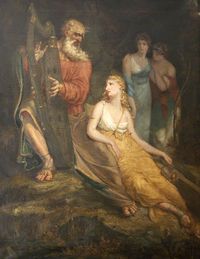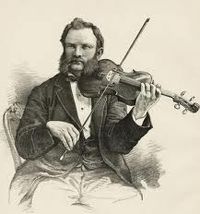Annotation:Ossian: Difference between revisions
No edit summary |
m Text replacement - "garamond, serif" to "sans-serif" |
||
| (2 intermediate revisions by one other user not shown) | |||
| Line 1: | Line 1: | ||
=='''Back to [[{{BASEPAGENAME}}]]'''== | =='''Back to [[{{BASEPAGENAME}}]]'''== | ||
---- | ---- | ||
<p><font face=" | <p><font face="sans-serif" size="4"> | ||
'''OSSIAN.''' Scottish, Slow Air (4/4 time). F Sharp Minor. Standard tuning (fiddle). AAB. The elegiac air was printed in fiddler-composer J. Scott Skinner's '''Scottish Violinist''' (1900) and '''Harp and Claymore Collection''' (1904), and included in his section of "Pastoral Melodies and Heroic Airs." It was composed by Skinner himself, in | '''OSSIAN.''' Scottish, Slow Air (4/4 time). F Sharp Minor. Standard tuning (fiddle). AAB. The elegiac air was printed in fiddler-composer J. Scott Skinner's '''Scottish Violinist''' (1900) and '''Harp and Claymore Collection''' (1904), and included in his section of "Pastoral Melodies and Heroic Airs." It was composed by Skinner himself, in homage to the legendary Celtic bard Ossian, son of Fionn mac Cumhaill (Finn McCool), who was said to have lived around the 3rd century A.D. Poetry ostensibly written by Ossian [http://en.wikipedia.org/wiki/Ossian] was published in the early 1760's by James Macpherson (1736-1796) of Kingussie, Inverness-shire, who claimed to have copied the poems from original manuscripts, which he declined to produce. | ||
[[File:ossianandmalvina2.jpg|200px|thumb|left|Ossian and Malvina]] | [[File:ossianandmalvina2.jpg|200px|thumb|left|Ossian and Malvina]] Ossian and his poetry, while perhaps based on folklore, are now thought to have been largely fashioned by Macpherson, and has been called "the most successful literary falsehood in modern history." [[File:skinner.jpg|200px|thumb|right|J. Scott Skinner (1843-1927)]] | ||
<br> | <br> | ||
<br> | <br> | ||
</font></p> | </font></p> | ||
<p><font face=" | <p><font face="sans-serif" size="4"> | ||
''Source for notated version'': | ''Source for notated version'': | ||
<br> | <br> | ||
<br> | <br> | ||
</font></p> | </font></p> | ||
<p><font face=" | <p><font face="sans-serif" size="4"> | ||
''Printed sources'': Hardie ('''Caledonian Companion'''), 1992; pg. 104. Skinner ('''Harp and Claymore Collection'''), 1904; p. 7 (arranged for violin and piano by Gavin Greig). Skinner ('''The Scottish Violinist'''), 1900; p. 36. | ''Printed sources'': Hardie ('''Caledonian Companion'''), 1992; pg. 104. Skinner ('''Harp and Claymore Collection'''), 1904; p. 7 (arranged for violin and piano by Gavin Greig). Skinner ('''The Scottish Violinist'''), 1900; p. 36. | ||
<br> | <br> | ||
<br> | <br> | ||
</font></p> | </font></p> | ||
<p><font face=" | <p><font face="sans-serif" size="4"> | ||
''Recorded sources'': <font color=teal></font> | ''Recorded sources'': <font color=teal></font> | ||
</font></p> | </font></p> | ||
Latest revision as of 14:32, 6 May 2019
Back to Ossian
OSSIAN. Scottish, Slow Air (4/4 time). F Sharp Minor. Standard tuning (fiddle). AAB. The elegiac air was printed in fiddler-composer J. Scott Skinner's Scottish Violinist (1900) and Harp and Claymore Collection (1904), and included in his section of "Pastoral Melodies and Heroic Airs." It was composed by Skinner himself, in homage to the legendary Celtic bard Ossian, son of Fionn mac Cumhaill (Finn McCool), who was said to have lived around the 3rd century A.D. Poetry ostensibly written by Ossian [1] was published in the early 1760's by James Macpherson (1736-1796) of Kingussie, Inverness-shire, who claimed to have copied the poems from original manuscripts, which he declined to produce.

Ossian and his poetry, while perhaps based on folklore, are now thought to have been largely fashioned by Macpherson, and has been called "the most successful literary falsehood in modern history."

Source for notated version:
Printed sources: Hardie (Caledonian Companion), 1992; pg. 104. Skinner (Harp and Claymore Collection), 1904; p. 7 (arranged for violin and piano by Gavin Greig). Skinner (The Scottish Violinist), 1900; p. 36.
Recorded sources:
